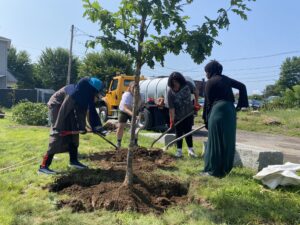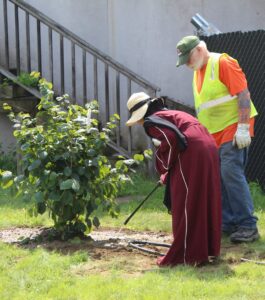
On a blistering hot day this past July, if you were passing by 75 Lincoln Street in Lewiston, you would have been treated to quite a sight: about a dozen young women with shovels, rakes, and work gloves, working side by side with members of the Lewiston Public Works department, planting trees.
The youth, members of a summer program called Sprout Lewiston, planted 14 trees that day—Witch Hazel, Black Gum, White Oak, Serviceberry, and Red Maple—as part of a plan to make this open space nicer by providing shade for people and creating habitat for wildlife.

Learning in Lewiston
Maine Audubon’s relationships in Lewiston originated in the community, within a few blocks and partners throughout the Tree Street neighborhood. A community leader and activist named Allie Smith got a ticket for not mowing a vacant lot she had purchased, and reached out to Maine Audubon for help educating municipal leaders and the community about conserving pollinators and restoring habitat for birds and other wildlife. Some introductions, a ridealong with the City code enforcement officer, and more trips to Lewiston ensued, and we were off and running on “Bringing Nature Home” in Lewiston.
Next came a youth development and habitat stewardship program, Sprout Lewiston, which Allie also helped us create in 2022 as part of her work with Healthy Homeworks, run in partnership with Maine Community Integration (mcimaine.org). MCI’s mission is to integrate New Mainers into their communities while respecting and uplifting their diverse cultures, identities, and traditions. We were thrilled to be introduced to MCI and are grateful to work so closely with them on this important community conservation project, now in its second summer. Over the course of 3.5 weeks this summer, 12 teens learned about ecology, met with environmental science professionals, restored native plants and wildlife habitat in Lewiston public parks, and had some fun in the outdoors!
Planning and Planting
 This summer’s tree planting was the culmination of a plan developed by Lewiston City Arborist Steve Murch and Bringing Nature Home manager Andrew Tufts. Steve and the Lewiston Public Works department have been engaged in and supportive of restoring habitat for birds and other wildlife in Lewiston from the start. Thanks to a boost in funding from U.S. Fish & Wildlife last year, they knew they would have thousands of dollars worth of plants to put in the ground, so needed to determine location and installation well in advance.
This summer’s tree planting was the culmination of a plan developed by Lewiston City Arborist Steve Murch and Bringing Nature Home manager Andrew Tufts. Steve and the Lewiston Public Works department have been engaged in and supportive of restoring habitat for birds and other wildlife in Lewiston from the start. Thanks to a boost in funding from U.S. Fish & Wildlife last year, they knew they would have thousands of dollars worth of plants to put in the ground, so needed to determine location and installation well in advance.
Like many historic New England mill towns, Lewiston has a number of vacant lots. Around the country, cities have begun realizing the potential of these open spaces, especially for providing access to green space. On a cold windy February morning, starting with a list of almost 30 vacant lots, Steve and Andrew took a ride around Lewiston in search of suitable sites. The selection process focused on criteria such as walkability, public vs private ownership, access to water, visibility, and connectivity.
Following these criteria, Steve and Andrew landed on two sites within three blocks of each other, both along main corridors. One site, located on Lisbon Street, will provide wildlife habitat along the main corridor through Lewiston’s downtown, and we planted five trees there. The 75 Lincoln Street site—where the youth planted 14 trees—is adjacent to the Farmers’ Market, and will provide an additional gathering area to this important cultural node that offers a market every Sunday. Steve told the youth that people come from all over the region for the Farmers’ Market and spill over into this area. “Shade will make it so much nicer,” he said, “and it will create habitat for wildlife.” Staff from the Farmers Market has offered to help water the site.

The tree planting took place during the final days of this summer’s Sprout Lewiston program, and the participants talked about their favorite moments from the past weeks. Lorraine, who had tirelessly shoveled dirt, hauled compost, and maneuvered wheelbarrows, said her favorite part was “Going on the walks, and being able to share a moment with everyone.” Koos, the MCI Youth Coordinator, said “getting to know everyone” was the best part. Other highlights included learning about wildlife and taking field trips to places including Wolfe’s Neck State Park and Gilsland Farm Audubon Center.
Mary Herman, Director of Special Projects in the Office of the Commissioner, Department of Education, was on hand at the planting as well, to see results firsthand of the MDOE’s Outdoor Learning Initiative, a statewide effort to increase student access to hands-on, outdoor learning experiences over the summer. Maine Audubon was the recipient of a grant from MDOE to engage middle and high school students in summer forest ecology education, habitat stewardship, and career development programming like Sprout and the Portland Youth Corps.
By the middle of the day, the bare area of grass had been transformed into a park ringed by young trees that will grow into beautiful and mature habitat for wildlife and provide shade and respite for people. The youth talked about how amazing it will feel to return to the park 20 years from now, to stand in the shade of a fully grown oak tree, and tell anyone walking by, “I did this.”
Maine Audubon is grateful for the Maine Community Foundation, Maine Department of Education, and U.S. Fish & Wildlife for funding our work with Sprout Lewiston. We would also like to thank Healthy Homeworks and Stanton Bird Club for their ongoing partnerships in Lewiston.
